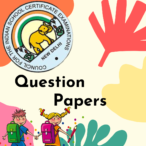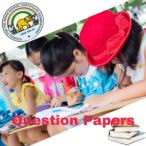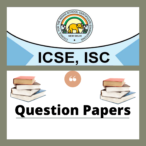LITERATURE IN ENGLISH
ENGLISH Paper – 2
SECTION A – DRAMA
The Merchant of Venice : Shakespeare
![]() Q.1. Read the extract given below and answer the questions that follow:
Q.1. Read the extract given below and answer the questions that follow:
Portia: Go draw aside the curtains, and discover
The several caskets to this noble prince —
Now make your choice.
Morocco: The first, of gold, who this inscription bears,
“Who chooseth me shall gain what many men desire”;
(i) Who is Morocco? How did he introduce himself to Portia when they first met in an earlier scene?
(ii) How would Morocco know that he had made the right choice? What would his reward be?
(iii) Which casket did Morocco finally choose? What reasons did he give for
(iv) What two objects does Morocco find in the casket of his choice? What reason does he give to Portia for leaving in haste?
(v) How does Portia respond to Morocco’s parting words? What does this reveal of her nature?
![]() Q.2 Read the extract given below and answer the questions that follow:
Q.2 Read the extract given below and answer the questions that follow:
Bassanio : Were you the doctor, and I knew you not?
Gratiano : Were you the clerk?
Antonio : Sweet lady, you have given me life and living;
For here I read for certain that my ships
Are safely come to road.
Portia : How now, Lorenzo!
My clerk hath some good comforts too for you.
(i) Where does this scene take place? What had Portia directed Antonio to give to Bassanio just moments before the above words were spoken?
(ii) Portia had just given Antonio, Bassanio and Gratiano a letter to read. Who had written this letter? What does Bassanio learn about Portia from this letter?
(iii) What good news does Portia have for Antonio? How does he respond to it? (iv) To whom does Portia refer as ‘My clerk’? What ‘good comforts’ does the ‘clerk’ have for Lorenzo?
(v) How was Bassanio persuaded to give away the ring that Portia had given him at the time of their marriage? What does this reveal of Bassanio’s relationship with Antonio?
OR
Loyalties : John Galsworthy
![]() Q.3 Read the extract given below and answer the questions that follow:
Q.3 Read the extract given below and answer the questions that follow:
Margaret : Here’s the wind!
Winsor : What’s the move now, General?
Canynge : You and I had better see the Inspector in De Levis’s room, Winsor.
[To the others] If you’ll all be handy, in case he wants to put questions for himself.
Margaret : I hope he’ll want me; it’s just too thrilling.
Dancy : I hope he won’t want me; I am dog-tired. Come on Mabel. [He puts his arm in his wife’s]
Canynge : Just a minute, Charles.
(i) Who is Margaret? Why does she say ‘Here’s the wind!’?
(ii) Why does Canynge suggest that they see the Inspector in De Levis’ room? What does Margaret find ‘thrilling’?
(iii) Who enters soon after? What had this person been asked to do earlier?
(iv) How does De Levis happen to have such a large sum of money on that particular day? What steps does he take to keep the money safe?
(v) Whom does De Levis suspect of having stolen his money? What leads Canynge to suspect the same person? What is Canynge’s opinion of this person?
![]() Q.4 Read the extract given below and answer the questions that follow:
Q.4 Read the extract given below and answer the questions that follow:
Mabel : A prosecution? Prison? Oh, go! Don’t wait a minute! Go!
Dancy : Blast them!
Mabel : Oh, Ronny! Please! Please! Think what you’ll want. I’ll pack.
Quick! No! Don’t wait to take things. Have you got money?
(i) Where is this scene set? What had Dancy just confessed to Mabel?
(ii) What had Dancy’s lawyer suggested he should do? Why had he made this suggestion?
(iii) How does Mabel express her loyalty to Dancy soon after he had made the confession? Who knocks at the door at this point?
(iv) Who else enters the house? What sound do they all hear? Why does Mabel faint?
(v) What message did Dancy’s letter contain? What is your opinion of Dancy at the end of the play?
SECTION B – POETRY
A Collection of Poems
![]() Q.5 Read the extract given below and answer the questions that follow:
Q.5 Read the extract given below and answer the questions that follow:
“I’m grateful, Sir”, he whispered, as I handed my canteen
And smiled a smile that was, I think, the brightest that I’ve seen.
“Seems silly a man my size so full of vim and zest
Could find himself defeated by a small pain in his chest.”
(Small Pain in My Chest – Michael Mack)
(i) Where is ‘he’ when the narrator encounters him? Describe the scene around him.
(ii) What does ‘he’ ask the narrator for? What reasons does he give for his request?
(iii) What does the narrator see when he looks at him? How do we know that ‘he’ is very young and completely unaware of the seriousness of his injury?
(iv) How does ‘he’ describe the battle that had been fought the night before and his role in it?
(v) What feelings do you think the narrator must have experienced when he ‘put his arms around him’?
What is the central theme of this poem?
![]() Q.6 Read the extract given below and answer the questions that follow:
Q.6 Read the extract given below and answer the questions that follow:
I am going out rarely, now and then
Only, this is price of old age
But my health is O.K.
(The Professor – Nissim Ezekiel)
(i) Who is the speaker? What relationship did he share with the listener?
(ii) How many sons does the speaker have? What does he say about them?
(iii) What are the names of the speaker’s daughters? Why does the speaker believe that his daughters are ‘well settled in life’?
(iv) How old is the speaker? Why does he say that his health is ‘OK’? What reason does he give to explain his state of health?
(v) What characteristics typical of Indian speech and thought does the poet make fun of through this poem?
SECTION C – PROSE
A Collection of Short Stories
![]() Q.7 Read the extract given below and answer the questions that follow:
Q.7 Read the extract given below and answer the questions that follow:
Sher Singh could feel immediately the heat of the boy’s body burning through the cotton cloth.
He felt the weight too, and he wondered how he was going to manage.
‘He is too big for you’ said the mother. She spoke in the whisper of despair.
‘You will never get there.’
Sher Singh said nothing.
He set off.
(i) Who was the ‘boy’? Why was Sher Singh sure that the little boy would die?
(ii) What did Sher Singh’s father do for a living? Mention any two acts of courage he had performed that had earned him the title ‘Bahadur’.
(iii) How does his mother use her skill as a hill woman to prepare Sher Singh for his long and dangerous journey?
(iv) Mention any three challenges that Sher Singh encountered on his way to the hospital.
(v) How does the doctor at the hospital address Sher Singh at the end of the story?
Why do you think he refers to him in this way?
![]() Q.8 With close reference to the text, show how Stephen Leacock makes effective use of humour and exaggeration to describe his attempts to get back his ‘Lost Dollar’.
Q.8 With close reference to the text, show how Stephen Leacock makes effective use of humour and exaggeration to describe his attempts to get back his ‘Lost Dollar’.
OR
Animal Farm : George Orwell
![]() Q.9 Read the extract given below and answer the questions that follow:
Q.9 Read the extract given below and answer the questions that follow:
It was just after the sheep had returned, on a pleasant evening when the
animals had finished work and were making their way back to the farm
buildings, that the terrified neighing of a horse sounded from the yard.
Startled, the animals stopped in their tracks.
(i) From where did the sheep return? Under whose supervision were they? What were they taught while they were in this place?
(ii) Whose voice was it that startled the animals? What did the horse see that caused it to neigh in terror?
(iii) How did the animals react to this sight at first? Why were they not able to protest?
(iv) Why did Clover lead Benjamin gently to the end of the barn immediately after this? What did they find written on the wall?
(v) What strange and disturbing change did the animals observe in the pigs when they peered in at the dining room window later that evening? Comment on the irony of the situation.
![]() Q.10 Give a brief account of the Battle of the Cowshed and Snowball’s role in it.
Q.10 Give a brief account of the Battle of the Cowshed and Snowball’s role in it.
OR
To Sir With Love : E.R. Braithwaite
![]() Q.11 Read the extract given below and answer the questions that follow:
Q.11 Read the extract given below and answer the questions that follow:
As the bus moved slowly on, a bright-eyed little boy in school cap and blazer
paused momentarily beside the vacant seat and then quickly moved a little way on ….
The conductor approached with his cheery ‘Any more fares, please, free ride only after midnight.’
(i) Why did the schoolboy not occupy the vacant seat? What was he puzzled by?
(ii) Who was preparing to take the seat? What did the person do instead? Why?
(iii) What efforts did the conductor make to get this person to sit in the vacant seat?
(iv) What does the author do to help ease the situation? How does the conductor view the author’s action?
(v) What was the author’s intended destination? What is his state of mind as he approaches this place?
![]() Q.12 Give a brief description of Brathwaite’s encounter with a stranger at St. James Park. How did this meeting change the course of his life?
Q.12 Give a brief description of Brathwaite’s encounter with a stranger at St. James Park. How did this meeting change the course of his life?




